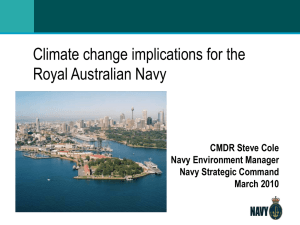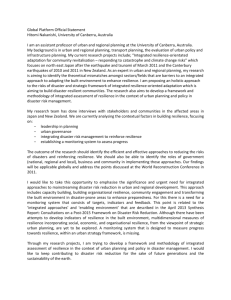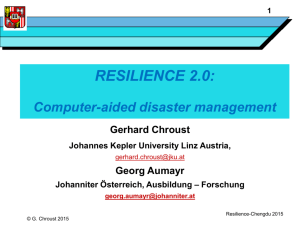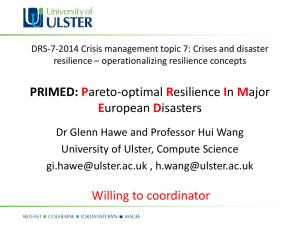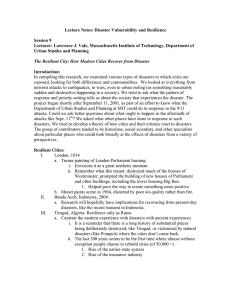Economic Resilience and Well-being of Gulf Communities
advertisement
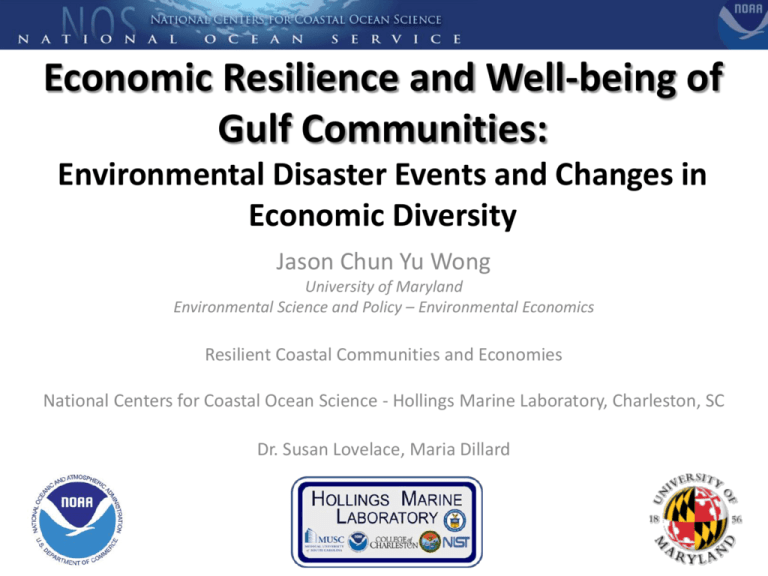
Economic Resilience and Well-being of Gulf Communities: Environmental Disaster Events and Changes in Economic Diversity Jason Chun Yu Wong University of Maryland Environmental Science and Policy – Environmental Economics Resilient Coastal Communities and Economies National Centers for Coastal Ocean Science - Hollings Marine Laboratory, Charleston, SC Dr. Susan Lovelace, Maria Dillard 1 2 Outline • • • • • • • • Motivation Questions Methodology Results & Analysis Future Research My Next Step Acknowledgement Sources 3 Motivation 4 Gulf of Mexico Timeline Hurricane Rita- $108,755 decrease in Revenue at Sea Rim State Park (Jefferson, TX) Hurricane Dennis$3.4b in property damages 2003 2004 Hurricane Ivan$6.6b in property damages (AL, FL, LA, MS) 2005 2006 2007 2010 Deepwater Horizon Oil Spill approx. 205.8 million gallons Hurricane Katrina- Total Resident Population declined from 455,188 on July 1, 2005 to 208,548 on July 1, 2006 in Orleans, LA 5 6 Why do we care about economic diversity? • Conventional wisdom: portfolio and risk diversification – shock resistance • Don’t put all your eggs in one basket! 7 Research Questions • Was there a significant difference in economic diversity over time, from 2003-2007, in Gulf States counties? • What socioeconomic factors could help explain economic diversity? Does the number of environmental disaster events affect economic diversity? • How could we interpret economic resilience from diversity indicators? 8 Measuring Economic Diversity By Employment, or Earnings Secondary Data Needs: U.S. Census, Bureau of Economic Analysis 9 Measuring Economic Diversity • This study uses four static measures: Ogive, National Average, Herfindahl, and Entropy/Log Share • T-Tests, Wilcoxon Rank Sum, Correlation and Regression Analysis National Average 𝑆𝑖 𝑁𝑖 = 𝑠=1 Ogive 𝑆𝑖 𝑂𝑖 = 𝑠=1 𝑒𝑠𝑖 𝑒𝑠 − 𝑒𝑖 𝑒 𝑒𝑠 𝑒 2 𝑒𝑠𝑖 1 − 𝑒𝑖 𝑠𝑖 1 𝑠𝑖 2 10 11 12 Results: Difference in Diversity? Distribution of 𝐷03−07 (𝑁𝑖), by employment 13 Wilcoxon Signed-Rank Results Non-Coastal, n=441 Coastal, n=139 Paired Years Indicator 2003-2007 0.0131 2003-2007 0.0346* 2003-2007 0.0624* 2003-2007 -0.0647* • Coastal counties experienced less significant changes in industrial composition compared to noncoastal counties from 2003-2007 * Pr > |S| < 0.05 14 Results: What can help explain economic diversity? • Correlation: using existing socioeconomic dataset on coastal counties, selected variables based on literature and data availability • Count of Environmental Disaster Events in 2005 included • Ran multiple regressions (standard, Max R, Stepwise); checked for multicollinearity with Variance Inflation Factor 15 Correlation 2007 2007 Pearson R Pearson R % Working age -0.01360 -0.10700 % Female -0.35496* -0.11879 % Hispanic/Latino 0.26036* 0.21240* Income per capita -0.24315* -0.25622* Poverty rate 0.09405 0.05459 Unemployment -0.06750 0.10999 Environmental disaster events, 2005 -0.23995* -0.21269* * Pr > |r| < 0.05 16 Regression Variance Inflation Factor 2007 β β R2 0.2640 0.1512 - Intercept 12.70078 1.66464 0 % Working age -0.05408 -0.00268 1.95517 % Female -0.13964* -0.00409 1.82239 % Hispanic/Latino 0.01037* 0.00253* 1.43765 Income per capita -0.00002434 -0.00001154* 1.91350 Poverty rate -0.00597 -0.01204* 2.10565 Unemployment -0.19043* 0.01005 1.49754 Environmental disaster events, 2005 -0.03147 -0.00765 1.09909 * Pr > |t| < 0.05 17 Limitations • Time frame & boundary problem • Population may have a threshold effect • Factors requiring population-adjusted measures: Education, Resource availability • Specialization may be stable • Diversity measures sensitive to number of industries 18 Economic Resilience • Employment diversity = resilience? • How to measure the ability of communities “bounce back” • Simulation-based modeling – Using Computable General Equilibrium (CGE) – Hypothetical, constructed measure • Retrospective data analysis – Adapted the resilience method for ex post facto resilience analysis 19 Conclusion • Framework for economic well-being assessment • Industrial composition in coastal communities is “mature” and established • Environmental disasters were not a strong explanatory variable for economic diversity • Time frame may be a significant factor that is industry-dependent • Future research – finance and input-output methods 20 My Next Step… • Honors Thesis – Contingent Valuation Survey – Rain Gardens • Germany Study Abroad – International Environmental Law • Interdisciplinary PhD in Environment and Resources: Environmental Economics, Sociology, Law, Policy • Economics of Climate Change and Valuation of the Environment; Non-Market Valuation Techniques; Survey Methodology • A teacher, a researcher, and a scholar in environmental economics and policy 21 Acknowledgements • • • • • • • • • Susan Lovelace Maria Dillard Lauren Brown, C of C MES ‘12 Mark Plummer, NMFS, NWFSC Peter Edwards, NMFS, Habitat Jeffery Adkins, NOS, CSC Linwood Pendleton, Acting Chief Economist HML Human Dimensions Lab Members HML admin and IT staff; OEd Scholarship Team 22 Sources • • • • • • • US Census, Bureau of Economic Analysis Wagner, J. E. (2000). "Regional Economic Diversity: Action, Concept, or State of Confusion." Journal of Regional Analysis & Policy 30(2): 1-22. Rose, A. L., Shu-Yi (2005). "Modeling Regional Economic Resilience to Disasters: A Computable General Equilibrium Analysis of Water Service Disruptions." Journal of Regional Science 45(1): 75-112. Rose, A. (2004). "Defining and measuring economic resilience to disasters." Disaster Prevention and Management 13(4): 307-314. State of Hawaii (2008). Measuring Economic Diversification In Hawaii, Research and Economic Analysis Division, Department of Business, Economic Development and Tourism, State of Hawaii. Manyena, S. B. (2006). "The concept of resilience revisited." Disasters 30(4): 435450. Quigley, Thomas M.; Haynes, Richard W; Graham, Russell T., tech. eds. 1996. Integrated scientific assessment for ecosystem management in the interior Columbia basin and portions of the Klamath and Great Basins. Gen. Tech. Rep. PNW-GTR-382. Portland, OR: U.S. Department of Agriculture, Forest Service, Pacific Northwest Research Station 23 Thank you! 24 ex post facto resilience indicator • 𝑅𝑖 = • • 𝑝𝑖 −𝐸(𝑝𝑖 ) , 𝐸(𝑝𝑖 ) 𝐸(𝑝𝑖 ) ≠0 Where psi= actual performance of industry s in region i And E(psi)= expected performance of industry s in region i. • For 𝐸(𝑝𝑖 ) ≠ 0, • 𝑅𝑖 = 0 𝑤ℎ𝑒𝑛 𝑝𝑖 = 𝐸(𝑝𝑖 ), the event had no effect on the ability of the economy to meet its expected performance; • 𝑅𝑖 < 0 𝑤ℎ𝑒𝑛 𝑝𝑖 < 𝐸(𝑝𝑖 ), the event reduced the ability for the economy to meet its expected performance; • 𝑅𝑖 > 0 𝑤ℎ𝑒𝑛 𝑝 > 𝐸(𝑝𝑖 ), the event in fact increased the ability for the economy to meet its expected performance. 25



